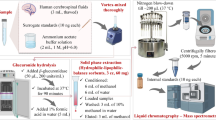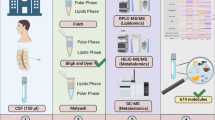Abstract
Per- and polyfluoroalkyl substances (PFASs) are potentially neurotoxic compounds. Levels of PFASs in cerebrospinal fluid (CSF) could directly reflect their potential harm to the central nervous system. Because of the variety of PFASs and the rarity of CSF, there is an urgent need to establish a rapid online method to detect a broad spectrum of PFASs accurately and simultaneously by consuming a small amount of CSF. In this study, we developed a fast and automated method to analyze 52 PFASs in human CSF samples using online TurboFlow ultra-high-performance liquid chromatography–tandem mass spectrometry. Our method offered excellent matrix-matched standard curve linearity (correlation coefficient > 0.99), good limits of quantitation (MLOQs) (0.01 to 0.08 ng mL−1), satisfactory accuracy (recoveries of 74.6%–119.1%) and precision (relative standard deviations of 1.4%–13.2%), small sample amount consumption (50 μL), and fast analysis time (18 min per sample) without complex sample pretreatment procedures. These are advantageous for the high throughput screening of PFASs in environmental epidemiology studies. Repeated freeze–thaw experiments showed that it was better to perform the analytical process soon as possible after sample collection. The established method was used to analyze PFASs in 60 people. Short-chain PFASs, perfluorobutanoic acid (PFBA), perfluoropentanoic acid (PFPeA), and novel PFASs [sodium 2-(N-ethylperfluorooctane-1-sulfonamido)ethyl phosphate (SAmPAP), perfluoroethylcyclohexanesulfonate (PFECHS), and perfluoro-3, 7-dimethyloctanoic acid (P37DMOA)] were reported in CSF for the first time. PFBA and PFPeA were detected in all samples with mean concentrations of 0.24 and 0.22 ng mL−1, respectively. We also calculated the blood–brain barrier transmission efficiency of PFASs (RPFAS), and the mean RPFBA value was above 1, which indicated that PFBA might transfer from serum to CSF.




Similar content being viewed by others
References
Lindstrom AB, Strynar MJ, Laurence E, L. Polyfluorinated compounds: past, present, and future. Environ Sci Technol. 2011;45:7954–61.
Giesy JP, Kannan K. Global distribution of perfluorooctane sulfonate in wildlife. Environ Sci Technol. 2001;35:1339–42.
Yeung LW, Miyake Y, Taniyasu S, Wang Y, Yu H, So MK, et al. Perfluorinated compounds and total and extractable organic fluorine in human blood samples from China. Environ Sci Technol. 2008;42:8140–5.
Decision SC-4/17; Stockholm convention on persistent organic pollutants. Geneva, Switzerland; 2009.
UNEP (United Nations Environment Programme). Proposal to list perfluorohexane sulfonic acid (CAS no: 355-46-4, PFHxS), its salts and PFHxS-related compounds in annexes A, B and/or C to the Stockholm convention on persistent organic pollutants (UNEP/POPS/POPRC.13/4). In: The thirteenth meeting of the persistent organic pollutants review committee. 2018. Available from: https://www.informea.org/en/decision/perfluorohexane-sulfonic-acid-pfhxs-its-salts-and-pfhxs-related-compounds. Accessed 26 Nov 2018.
UNEP (United Nations Environment Programme). Proposal to list pentadecafluorooctanoic acid (CAS No.: 335-67-1, PFOA, Perfluorooctanoic Acid), its salts and pfoa-related compounds in annexes A, B, and/or C to the Stockholm convention on persistent organic pollutants (UNEP/POPS/POPRC.12/11/Add.2.) In: The eleventh meeting of the persistent organic pollutants review committee. 2016. Available from: https://www.informea.org/en/decision/pentadecafluorooctanoic-acid-cas-no-335-67-1-pfoa-perfluorooctanoic-acid-its-salts-and-pfoa. Accessed 29 Mar 2016.
Lim XZ. Tainted water: the scientists tracing thousands of fluorinated chemicals in our environment. Nature. 2019;566:26–9.
Brendel S, Fetter É, Staude C, Vierke L, Biegelengler A. Short-chain perfluoroalkyl acids: environmental concerns and a regulatory strategy under REACH. Environ Sci Eur. 2018;30:9.
ECHA (European Chemicals Agency), Candidate list of substances of very high concern for authorisation. 2019. (TEM-0013.09) In: The accordance with Article 59(10) of the REACH Regulation. 2019. Available from: https://www.echa.europa.eu/candidate-list-table. Accessed 16 Jan 2020.
EU REACH SVHC (European union REACH Substances of Very High Concern), Restriction of per- and polyfluoroalkyl substances (PFAS) under REACH, 2020. Available from: https://echa.europa.eu/view-article/-/journal_content/title/restriction-of-per-and-polyfluoroalkyl-substances-pfas-under-reach-watch-online. Accessed 29 Oct 2020.
Liu Y, Zhou X, Wu Y, Yang X, Wang Y, Li S, et al. Exposure and blood-cerebrospinal fluid barrier permeability of PFASs in neonates. Environ Sci Technol Lett. 2022;9:64–70.
Daneman R. The blood-brain barrier in health and disease. Ann Neurol. 2012;72:648–72.
Senel M, Tumani H, Lauda F, Presslauer S, Mojib-Yezdani R, Otto M, et al. Cerebrospinal fluid immunoglobulin kappa light chain in clinically isolated syndrome and multiple sclerosis. PLoS One. 2014;9:e88680.
Grygorczuk S, Parczewski M, Swierzbinska R, Czupryna P, Moniuszko A, Dunaj J, et al. The increased concentration of macrophage migration inhibitory factor in serum and cerebrospinal fluid of patients with tick-borne encephalitis. J Neuroinflammation. 2017;14:126.
Levine JE, Povlishock JT. Becker DP the morphological correlates of primate cerebrospinal fluid absorption. Brain Res. 1982;241:31–41.
Nau R, Sörgel F. Eiffert H penetration of drugs through the blood-cerebrospinal fluid/blood-brain barrier for treatment of central nervous system infections. Clin Microbiol Rev. 2010;23:858–83.
Harada KH, Hashida S, Kaneko T, Takenaka K, Minata M, Inoue K, et al. Biliary excretion and cerebrospinal fluid partition of perfluorooctanoate and perfluorooctane sulfonate in humans. Environ Toxicol Pharmacol. 2007;24:134–9.
Wang J, Pan Y, Cui Q, Yao B, Wang J. Dai J penetration of PFASs across the blood cerebrospinal fluid barrier and its determinants in humans. Environ Sci Technol. 2018;52:13553–61.
Gao K, Fu J, Xue Q, Li Y, Liang Y, Pan Y, et al. An integrated method for simultaneously determining 10 classes of per-and polyfluoroalkyl substances in one drop of human serum. Anal Chim Acta. 2018;999:76–86.
Gao K, Gao Y, Li Y, Fu J, Zhang A. A rapid and fully automatic method for the accurate determination of a wide carbon-chain range of per- and polyfluoroalkyl substances (C4-C18) in human serum. J Chromatogr A. 2016;1471:1–10.
Steinledarling E, Reinhard M. Nanofiltration for trace organic contaminant removal: structure, solution, and membrane fouling effects on the rejection of perfluorochemicals. Environ Sci Technol. 2008;42:5292–7.
Rayne S, Forest K, Friesen KJJJoES, A HP. Computational approaches may underestimate pK a values of longer-chain perfluorinated carboxylic acids: implications for assessing environmental and biological effects. J Environ Sci Heal. 2009;44:317–26.
Reference and handling guide: perfluoroalkyl compounds, Accessible from, http://www.well-labs.com/docs/pfc_reference_handling_guide.pdf, (2015).
Ahrens L, Harner T, Shoeib M, Lane DA, Murphy JG. Improved Characterization of Gas–Particle Partitioning for Per- and Polyfluoroalkyl Substances in the Atmosphere Using Annular Diffusion Denuder Samplers. Environ Sci Technol. 2012;46:7199.
Wang Z, Xie Z, Möller A, Mi W, Wolschke H, Ebinghaus R. Atmospheric concentrations and gas/particle partitioning of neutral poly- and perfluoroalkyl substances in northern German coast. Atmos Environ. 2014;95:207–13.
Ullah S, Alsberg T, Berger U. Simultaneous determination of perfluoroalkyl phosphonates, carboxylates, and sulfonates in drinking water. J Chromatogr A. 2011;1218:6388–95.
Zabaleta I, Bizkarguenaga E, Iparragirre A, Navarro P, Prieto A, Fernández LÁ, et al. Focused ultrasound solid–liquid extraction for the determination of perfluorinated compounds in fish, vegetables and amended soil. J Chromatogr A. 2014;1331:27–37.
Houtz E, Wang M. Park JSJES, technology identification and fate of aqueous film forming foam derived per- and Polyfluoroalkyl substances in a wastewater treatment plant. Environ Sci Technol. 2018;52:13212–21.
Yu CH, Patel B, Palencia M, Fan Z. A sensitive and accurate method for the determination of perfluoroalkyl and polyfluoroalkyl substances in human serum using a high performance liquid chromatography-online solid phase extraction-tandem mass spectrometry. J Chromatogr A. 2017;1480:1–10.
Ding H, Peng H, Yang M, Hu J. Simultaneous determination of mono-and disubstituted polyfluoroalkyl phosphates in drinking water by liquid chromatography–electrospray tandem mass spectrometry. J Chromatogr A. 2012;1227:245–52.
Couchman L. Turbulent flow chromatography in bioanalysis: a review. Biomed Chromatogr. 2012;26:892–905.
Herman JL, Edge T, Majors RE. Theoretical concepts and applications of turbulent flow chromatography: LC GC North America; 2012. p. 30.
Gosetti F, Chiuminatto U, Zampieri D, Mazzucco E, Robotti E, Calabrese G, et al. Determination of perfluorochemicals in biological, environmental and food samples by an automated on-line solid phase extraction ultra high performance liquid chromatography tandem mass spectrometry method. J Chromatogr A. 2010;1217:7864–72.
Salihovic S, Karrman A, Lindstrom G, Lind PM, Lind L, van Bavel B. A rapid method for the determination of perfluoroalkyl substances including structural isomers of perfluorooctane sulfonic acid in human serum using 96-well plates and column-switching ultra-high performance liquid chromatography tandem mass spectrometry. J Chromatogr A. 2013;1305:164–70.
Bartolomé M, Gallego-Picó A, Huetos O, Lucena MÁ, Castaño A. A fast method for analysing six perfluoroalkyl substances in human serum by solid-phase extraction on-line coupled to liquid chromatography tandem mass spectrometry. Anal Bioanal Chem. 2016;408:2159–70.
Poothong S, Lundanes E, Thomsen C, Haug LS. High throughput online solid phase extraction-ultra high performance liquid chromatography-tandem mass spectrometry method for polyfluoroalkyl phosphate esters, perfluoroalkyl phosphonates, and other perfluoroalkyl substances in human serum, plasma, and whole blood. Anal Chim Acta. 2017;957:10–9.
Yao Y, Zhao Y, Sun H, Chang S, Zhu L, Alder AC, et al. Per-and Polyfluoroalkyl substances (PFASs) in indoor air and dust from homes and various microenvironments in China: implications for human exposure. Environ Sci Technol. 2018;52:3156–66.
Gao K, Zhuang T, Liu X, Fu J, Zhang J, Fu J, et al. Prenatal exposure to per- and Polyfluoroalkyl substances (PFASs) and association between the placental transfer efficiencies and dissociation constant of serum proteins-PFAS complexes. Environ Sci Technol. 2019;53:6529–38.
Acknowledgments
This work was financially supported by the National Natural Science Foundation of China (No. 21876005, 22206009), Natural Science Foundation of Beijing Municipality (No. 7192040), Capital Health Research and Development of Special Fund (No. 2020-2-2056), and Open Fund of the State Key Laboratory for Quality and Safety Hazard Factors and Risk Prevention and Control of Agricultural Products Jointly Built by the Province and the Ministry (No. 2021DG700024-KF202216). We thank LetPub (www.letpub.com) for their linguistic assistance during the preparation of this manuscript.
Author information
Authors and Affiliations
Corresponding authors
Ethics declarations
Human CSF samples were collected from inpatients in the Department of Neurology, Beijing Tongren Hospital. The use of human samples was approved by the appropriate ethics committee (Beijing University of Technology Ethics Committee) and the study was carried out in accordance with ethical standards.
Conflicts of interest
The authors declare that they have no competing financial interests or personal relationships that could have appeared to influence the work reported in this paper.
Additional information
Publisher’s note
Springer Nature remains neutral with regard to jurisdictional claims in published maps and institutional affiliations.
Supplementary Information
ESM 1
(DOCX 759 kb)
Rights and permissions
Springer Nature or its licensor (e.g. a society or other partner) holds exclusive rights to this article under a publishing agreement with the author(s) or other rightsholder(s); author self-archiving of the accepted manuscript version of this article is solely governed by the terms of such publishing agreement and applicable law.
About this article
Cite this article
Shang, J., Gao, K., Chi, B. et al. Automated and fast online method for simultaneously determining a broad spectrum of per- and polyfluoroalkyl substances in a small volume of cerebrospinal fluid. Anal Bioanal Chem 415, 1221–1233 (2023). https://doi.org/10.1007/s00216-022-04507-4
Received:
Revised:
Accepted:
Published:
Issue Date:
DOI: https://doi.org/10.1007/s00216-022-04507-4




